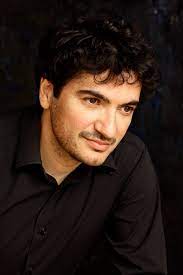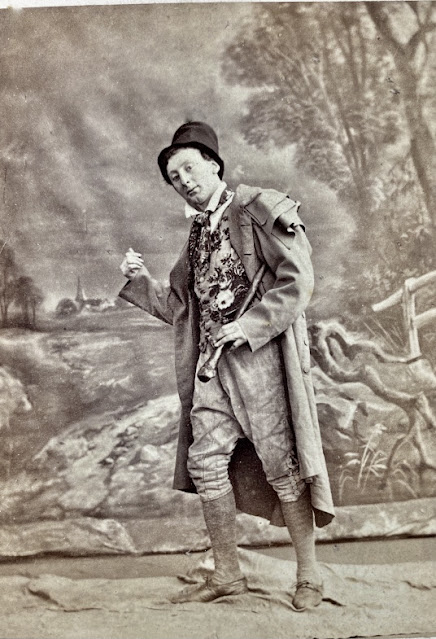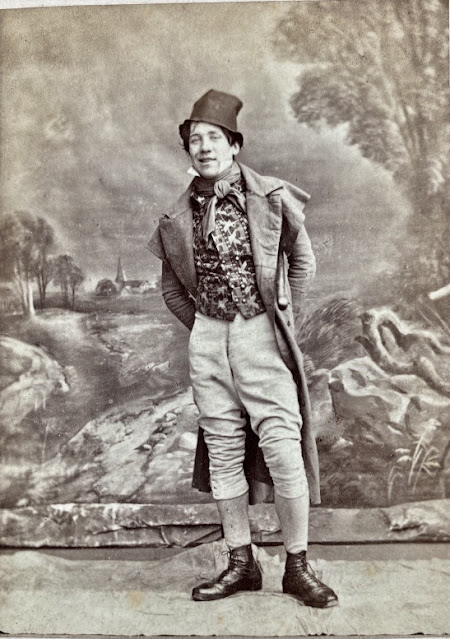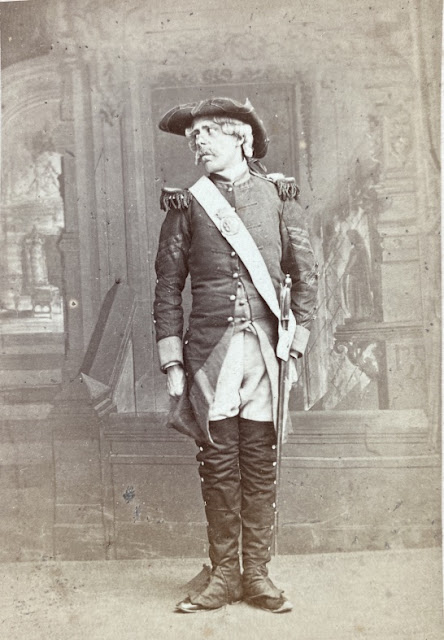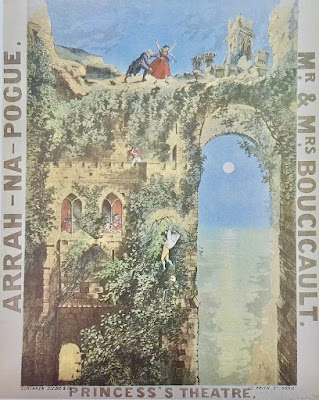This morning, I lit upon this photo of a nice old gentleman from Tasmania. Since it was labelled I thought I'd investigate a touch ...
Thomas FALL. Ah, Jewish?
Well, it turned out that Mr Fall was really easy to find out a bit about. What was he? Why, a pubkeeper! But not just that. Since his arrival in Van Dieman's Land in the1830s he had indeed been landlord of several pubs -- the Portland Inn at Long Meadow, Magpie Hill, then the Patriot King William IV at Evandale and finally the Clarendon in the same town, where he remained for over 40 years. But Thomas was smart. I see, from 1836, him buying and/or leasing property in the Evandale area ...
 |
| Clarendon in 1915 |
Thomas married in Tasmania (12 February 1838), Miss Elizabeth Russell, and they had two daughters: Elizabeth 1838-1931 and Kate (1842-1935, Mrs William Hartnoll). Mrs Fall died 19 October 1874, Thomas 4 September 1888. And the press gave him a fine obituary:
'The deceased gentleman will be greatly missed on the township, as he was a resident of 50 years. There were very few houses here when he came to make Evandale his home, he was a large property holder here and in Launceston, and having only had two in family, they are left well provided for. He arrived in the colony in the barque Portland in 1832 (sic), the late Mr and Mrs J. Cox, of Clarendon, being also amongst the passengers. The vessel, it will be remembered, was wrecked at the Fourteen Mile Bluff. The deceased succeeding in saving Mrs Cox from a watery grave, but her son was lost, the remains afterwards being interred at George Town. Mr Fall lost all he possessed by the wreck, but he commenced business in Launceston, and removed to Franklin Village, and finally settled at Evandale. After being in the colony a few years, he married a Miss Russell, cousin of Henry Russell, the celebrated composer and song writer. Although deceased had reached the age of 89 years, he could read without spectacles and write freely within a few days of his death. He never took an active part in politics, but was a shrewd observer and criticiser of passing events, and was charitable in his disposition.'
The wreck of the Portland (385 tons)? 1 October 1833. Had left Sydney (Captain: D G Coghill) 17 September. Councillor [William] James Cox was an Esq, MLC. And it wasn't a son, but an infant daughter who was drowned. Rebecca or Mary or Georgina. Oddly, though, the passenger list of those listed to sail, or those reported 'saved' doesn't include Mr Fall.
Dr Charles Inches (ship's surgeon), Edward Lord, newly-wed John Samuel Uther, Miss Blandford, and Mrs Thompson with two children and servant, John MacMahon, Andrew Gallagher, John Davis, James Murray, John Murray, Michael Power, Henry Tully, John Stewart. Strange, that. The 50 horses, 30 cattle, and Mr Cox's collection of imported seeds and plants were all lost. The Launceston press seemed more worried about the goods, especially Mr Cox's 'nearly L1000 worth' and the cedar wood, than the people. But Tasmania should perhaps be glad that the 'seeds and plants' that Mr Cox was trying to 'introduce' to the island got drowned.
I don't see the 'everything' that Mr Fall was supposed to have lost on the manifest ... maybe the fifteen cases of claret? And anyway, part of the cargo was saved by the good ship
Ann and brought ashore at Launceston and put up for sale ..
A letter being carried by the Portland from London was found on the beach ...
The legend of Thomas's (actual or imaginary) shipwreck went down in history, decorated with the usual historical improvements ...

But this little item suggests that the Portland had originated its voyage in England, in which case Thomas was only then, at over 30, emigrating ... yes, there it is berthing at Sydney in June 1833, bearing the London papers up to Febuary 18th .. the ship Portland, Captain William Ascough, from Cork, with 184 male prisoners arrived [26 June] .. having sailed 21st February ... a convict ship? 'The guard consists of 29 rank and file of the 21st Fusiliers, accompanied by four women and 11 children under command of Captain Frazer of the 26th regiment. Passengers: Lieutenant Wallace 16th Reg, D A C G Brackenbury Esq, Mrs Brackenbury, Miss Brackenbury and Miss Fraser'. Still no Mr Fall. 'The ship touched at Lisbon -- three men died of cholera -- six more of other diseases ... carrying 'three free passengers'. Well, Mr Fall wasn't one of those. The prisoners were offloaded at Sydney, so he wasn't one of those. Crew? Soldier? But they soldiers surely got off when the convicts did ...
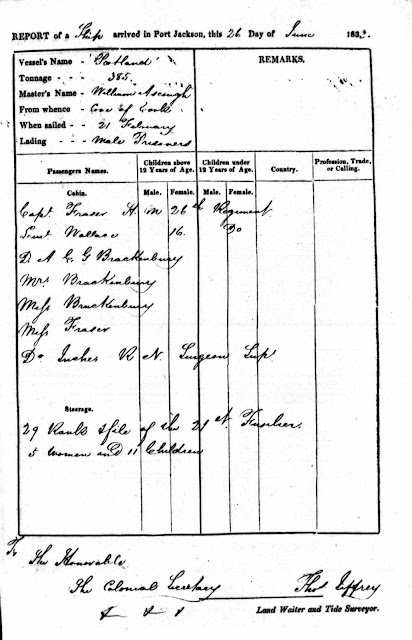
And Portland Head was thus named before the wreck. Ah! Journalism.
My first official sighting of him comes in 1837 ... tiens! I wonder if that's the same auctioneer Underwood who sold off the hulk of the Portland for L145.00. Anyhow, he's taken up Mr Moore's business in cattle and horse trading, seemingly on the Perth Road ...
Running a sales yard? But by October he's at the Portland Inn ... and on his way, as a wheeler-dealer publican ..
And he is married. Cousin of Henry Russell? Really? THE great Henry Russell of 'Cheer Boys Cheer' and 'The Maniac' fame? Well, yes, he was Jewish ... from Sheerness in Kent. Born c1814. Elizabeth was born in 1804 ... in Sheerness ..? Well, damme, it's true! Henry was the son of Moses Russell, and Elizabeth was the daughter of Moses's brother Philip .. blow me down! And oh dear ...
Geni says Catherine Keila [Uri Feiss] Russell is your great uncle's brother's wife's sister's ex-husband's uncle's wife's brother's wife's second cousin's wife's first cousin's husband's grandmother. Catherine was Elizabeth's mother.
So, I'm infintesimally related by a network of Jewish (and occasionally not) marriages to ... Henry Russell! Well, to Thomas Fall, too, but .. Henry Russell!
No one seems to have said where Thomas came from. That trip (or not) on the Sydney to Tasmania Portland is his 'first appearance'. But he was undoubtedly from England, and there is one thus named who seems to fit the bill and, indeed who has been claimed on Familysearch. He was the first-born son of Thomas Fall (Coventry 25 December 1776), from Warwickshire, and his wife Johanna née Archer, and he was christened in Coventry in November 1799. Round about that time, the family moved to Southwark, where Johanna produced a run of further children, of whom two other sons survived infancy, before dying of dropsy in 1812, at the age of 33. Father Fall remarried, and his second wife, seemingly Elizabeth née Gunn, gave him several more children. It was a large, sprawling family of which some remnants can be seen at 22 Charles Street, Stepney, in 1851: Thomas, baker, two unmarried daughters (Joanna and Elizabeth), and two nephews ... but it all gets rather muddly in 1853 when Thomas Fall (baker) son of Edward Fall (carpenter), marries this Johanna Fall, (1817-1883) daughter of Thomas Fall (carpenter) ...
By then, of course, our Thomas was at the other end of the world.
I see that in 1838 his assigned convict servant, Frederick Bond, had his transportation extended by three years for stealing .. a roll of ribbon?!
Here he is in the early 1840s ...
and forty years later
End of story. What other (very) distant relations shall I find ...
But did he or didnt he sail on the last voyage of the Portland ... what do you think?












